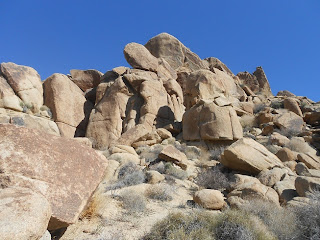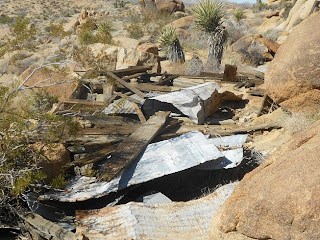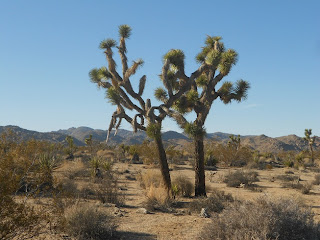 |
| Start of the Mastodon Peak Trail |
The Meeting Place of Two Deserts
The Colorado Desert,, a western extension of the Sonoran Desert, is found in the southern and eastern parts of the park. The southern boundary of the Mojave Desert reaches across the northern section of the park.
The Colorado Desert is of lower elevation than the Mojave. Most of the desert lies below 1,000 feet elevation. It's lowest point is in the Salton Sea at 275 feet below sea level. The area is known for it's strong winds and rather sparse rainfall. From northwest Mexico, the Colorado Desert, a part of the Sonoran Desert, encompasses approximately 7 million acres.
 | |
| Rock outcroppings, Joshua Tree Nat'l Park | ' |
Hiking Trails
Joshua Tree National Park features six official hiking trails. They are the 16 mile round trip Boy Scout Trail, the 3 mile round trip 49 Palms Oasis Trail, the 4 mile Lone Horse Mine Trail, the 7.2 mile Lost Palms Oasis Trail, the 3 mile Mastodon Peak Trail and the 3 mile Ryan Mountain Trail. In addition to these , thirty-five miles of the California Riding and Hiking Trail pass through Joshua Tree.
The trail featured in this article is the Mastodon Peak Trail which is in the southern section of the park. Like many of the Joshua Tree hiking trails, part of the fun is in the history that surrounds the entire area. The Mastodon Peak Trail is a three mile loop which begins at Cottonwood Spring. Cottonwood Spring is located just seven miles from the park's south entrance and at one time was an important water stop for miners and freighters. The first mention of Cottonwood Spring goes back to an 1875 gold mine claim. Because water was a necessity for mining, several gold mines were located in the area of Cottonwood Spring.
 |
| Remains of old Mastodon Mine |
The Mastodon Peak Trail is an interpretive trail that highlights a great deal of the desert flora and fauna. This particular hike is easy to combine with the Lost Palms Oasis Trail. The trail runs through a canyon with many palm stands. Both trails begin just off the Cottonwood Spring parking lot. Like with all hiking trips, the National Park Service advises to stay on the trails and bring along plenty of drinking water.
Bicycling is allowed in the park on both paved and unpaved roads but is not allowed on hiking trails.
 |
| Joshua Trees in the scenic desert park |
Joshua Tree National Park is an 800,000 acre desert park. The unique Joshua Tree is found in the western section of the park. The name "Joshua Tree" was first given this particular plant by the Mormon settlers who traveled across the Mojave desert in the mid 1800's. The name was chosen because it reminded the settlers of a bible passage where Joshua raises his hands to the sky in prayer. The Mormon settlers traveled to the area of today's Joshua Tree National Park with the goal of raising cattle and gold mining. The limbs and trunks of the Joshua Tree were used for fencing and corrals. The tree was also used for fuel for the steam engines used for ore processing.
The Joshua Tree is a member of the Agave family. The Joshua Tree is a monocot in the subgroup of flowering plants that includes grasses and orchids. The Joshua Tree starts life by seeding along with the required well timed rains. Along with this, the tree requires a winter freeze. It's thought that the freeze damages the growing end of the branch and allows for flowering. The flowering then creates more branches. The Joshua Trees you'll see inside the park which are straight stalks indicate that they never bloomed. The tallest Joshua Tree within the park stands some forty feet tall.
The Joshua Tree is an important part of the overall Mojave Desert ecosystem. The Joshua Trees provide a home for several insects, mammals, birds and lizards.
Links to two additional Western Trips articles you'll enjoy is the story of Death Valley Scotty and Scotty's Castle and the Rhyolite and Goldfield Nevada Mining Boom.
 |
| Visitor Center at Twenty Nine Palms, CA |
The park is located about 140 miles east of Los Angeles California. Two park entrances to Joshua Tree are off California Hwy 62 at the towns of Joshua Tree and Twenty Nine Palms. The third entrance is at the south end of the park off Interstate 10 about a thirty three mile drive east of Indio California.
A visit to Joshua Tree National Park offers a multitude of experiences. Whether you're hiking the scenic trails, camping at one of the park's campgrounds, exploring the truly unique desert flora and fauna, some of which is only found at Joshua Tree, or enjoying the rugged rock outcroppings and historic sites, Joshua Tree National Park is the perfect addition to your southern California family vacation planner.
(Photos from author's private collection)
View Larger Map

